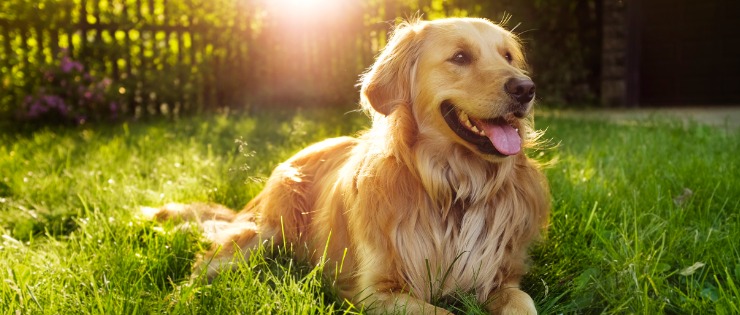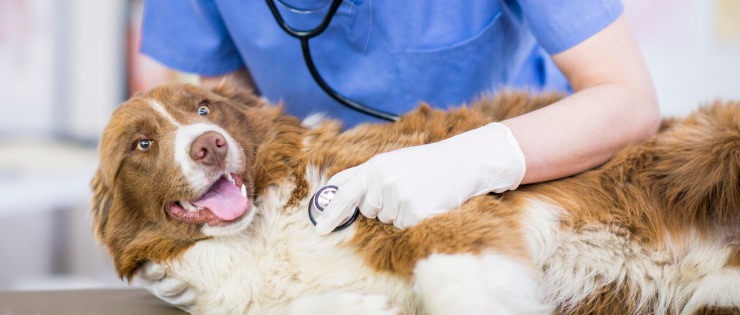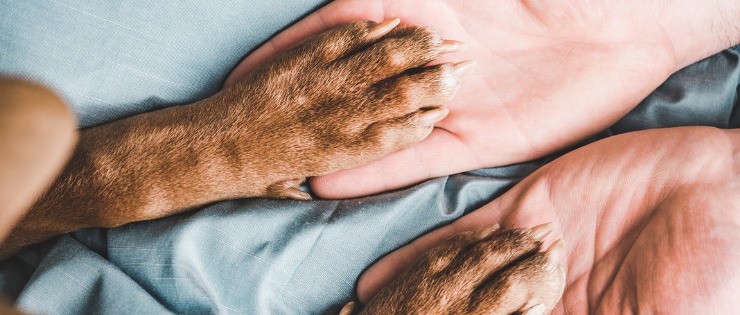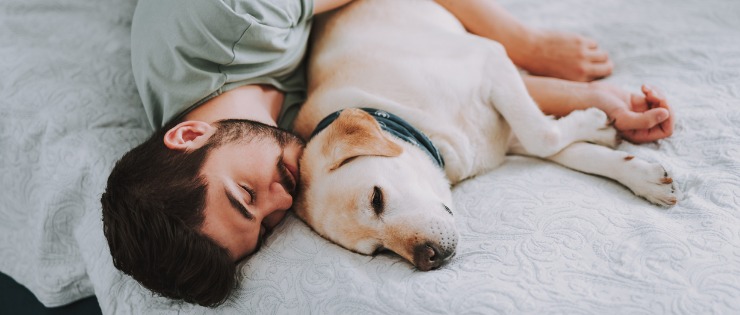
Just like humans, cancer is common in dogs in their later years. Around 50% of dogs will develop some form of cancer after the age of 10. Dogs are living longer, so cancer and other later life diseases are more common than they were previously.
Skin cancer is the most common type of cancer in dogs. It’s important to know what to look out for and when to seek treatment to ensure your dog has the best chance of recovery.
Types of Skin Cancer in Canines
Dogs, like humans, can have benign or malignant (cancerous) tumours.
Benign Tumours
Many tumours are benign (non-cancerous) and don’t spread. Known as melanocytomas, they can appear anywhere on the body as fatty tumours or growths that look like a mole. Even tumours in the glands are often benign. Some benign tumours are left alone while others are surgically removed and the tissue sent for a biopsy to ensure it isn’t malignant.
Similar to glandular tumours, hair follicle tumours are usually benign but it’s impossible to tell if the tumour is benign or malignant without a biopsy.
Benign melanocytomas are seen most commonly in miniature schnauzers, doberman pinschers and terriers often between the ages of five and 11 years.

Malignant Tumours
The three most common malignant skin cancers are mast cell tumours, malignant melanoma and squamous cell carcinoma.
Mast Cell Tumours
The most common type of skin cancer, the mast cell tumour, is linked to allergic reactions and the immune system. Chemicals called granules are released after being stimulated by an allergen. Mast cells are found throughout the body but a large proportion of these cells are located in the skin.
A diagnosis can be made by using a fine needle inserted into the tumour and a syringe extracts cells for analysis.

Malignant Melanoma
Malignant melanoma usually occurs on pigmented cells known as melanocytes. It’s thought that genes play a role in the development of melanomas.
This form of cancer is fast growing and can spread to other organs like the lungs and liver. When a dog licks an area on their body, the cells can multiply and mutate causing them to become cancerous. Trauma is also a possible cause of malignant melanoma.
Melanoma often starts as small brown or black masses but can also appear flat, wrinkled and as large tumours.
Squamous Cell Carcinoma
Like humans, squamous cell carcinomas are caused by sun exposure and usually occur in dogs that are light-skinned, hairless or almost hairless on parts of their body. The tumours appear as firm, raised and possible ulcerated plaques or nodules but can grow out into a large mass. Squamous cell cancer is often aggressive and multiple tumours will appear.
Symptoms of Skin Cancer
For the majority of pet owners, the first sign of skin cancer in their dog is a lump or bump. Their appearance varies from raised, wart-like lesions which are generally squamous cell carcinomas to inflamed sores which are most often mast cell tumours. Strange-looking lumps on the toenail beds are usually melanomas. Skin cancer lumps and bumps can be located all over dogs including the lips, mouth and pads of their feet.
Benign melanocytomas come in various colours from black and brown through to grey or red and size from tiny to several centimetres in diameter.
Skin Checks for Dogs
It’s important to check your dog’s skin regularly from the age of five for any sign of lumps, lesions and growths. Pay particular attention to the mouth, nose, eyes and ears as the face is at greatest risk.
Run your hands over the chest and neck making sure you part the fur to have a look for anything unusual. Next, run your hands from the armpits to the paws, then check the pads and nail beds. Check your dog’s belly and back, paying special attention to the breast and groin areas, looking for any swelling or lumps.
If you find a lump that is 1cm or larger or it has been there for more than one month, it’s best to see your vet.
Others signs to look out for include:
- Cuts or sores that don’t heal
- Unusual skin masses or lumps
- Scaly or crusty lesions
- Hairless masses or areas they lick often
- Redness or inflammation
- Itchy areas
- Wart-like lesions on the face
- Weight loss, lack of appetite
- Offensive smell
Bath time is ideal for looking over your dog’s skin for any changes, as the wet fur in some breeds makes it easier to see the skin.

Treatment for Skin Cancer
If you notice any kind of lump or growth on your dog’s skin, it’s best to have it checked out by your vet. Even though the majority (60-80%) of skin tumours in dogs are benign, many aren’t, and early treatment is the key to good survival rates.
Surgical removal of tumours is the most common treatment of skin cancer in dogs and will often cure or prolong a dog’s life. Once the growth is removed, it can be sent to pathology for determining if it’s cancerous and if any further treatment is recommended.
Treatment of mast cell tumours will depend on the grade of the tumour. If a pathologist determines the tumour is low-grade, surgery to excise the tumour is adequate treatment. High-grade tumours will require radiation therapy and chemotherapy to ensure the tumour doesn’t grow back in a different location on the body.
Treatment of squamous cell carcinoma usually involves surgery to remove the primary tumour. If it’s not possible to completely remove the tumour, radiation may be used to ensure it doesn’t regrow. Oral and topical steroids and drugs may also be used. There’s also a vaccine that stimulates the immune system to attack tumour cells in dogs with oral melanoma.
When radiation or chemotherapy is used, cancer will go into remission around 70% of the time, but may recur later.
Skin Cancer is More Common in Some Dog Breeds
Some dog breeds are more likely to develop skin cancer than others. The different types of skin cancers will appear more commonly in some breeds than others. Light-skinned and short coated breeds including dalmations, beagles, and bull terriers are most at risk of squamous cell carcinoma.
Mast cell tumours impact golden retrievers, beagles, pugs, shar peis, labradors, boxers and terriers more often than other breeds, however all dogs are susceptible.
All kinds of cancer are less common in mixed breed dogs due to their larger gene pool. But not all cancers are passed on through the genes, cancer can be spontaneous or have environmental causes.
Causes of Skin Cancer in Dogs
Genetics are a significant risk factor in developing skin cancer. Either the breed is more susceptible or the parents passed on the gene. Other factors include hormonal abnormalities, viruses such as the papilloma virus, and environmental factors such as the amount of sun exposure and chemicals.
There is little you can do to protect your dog from developing skin cancer except in those that are at increased risk from sun exposure. If your dog loves baking in the sun, apply a pet-friendly sunscreen (different from humans) to the tops of the ears and areas with little or no hair. Make sure your dog has plenty of enticing shady spots or bring them inside during the mid-day sun.

FAQs about Skin Cancer in Dogs
Here are some answers to frequently asked questions about skin cancer in dogs.
What Does Skin Cancer on Dogs Look like?
Skin cancers on dogs can look like lumps, bumps, sores and abrasions. Tumours can be a dark colour, raised, flat, wrinkled, sore-like or a lump almost hidden under the skin. Some dog owners dismiss a skin lesion as an injury or infection and see the vet when it doesn’t clear.
How Long Can Dogs Live with Skin Cancer?
There are many factors that influence the life expectancy of a dog with skin cancer. The majority of skin cancers are benign but some tumours may start out benign and can turn malignant if left untreated. Other forms of skin cancer such as malignant melanoma are fast growing, aggressive and can spread to other organs.
Some cancers require simple treatment while others require long and expensive treatments to prolong the dog’s life.
What Are the Signs of Your Dog Having Skin Cancer?
Apart from the visible lumps and bumps on the dog’s body, skin cancer may cause the dog pain, making them limp or yelp when touched.
How Treatable is Skin Cancer in Dogs?
Like most forms of cancer, the earlier it’s detected and treated, the better the outcome. Some cancers require no treatment, some are a quick surgical removal. Others may not be completely removed through surgery, or they may be aggressive and follow up radiation or chemotherapy is needed to destroy the remaining tumour.
How Much Does Treatment Cost?
Some benign lumps may be the cost of a vet visit to determine that it doesn’t require treatment. But other skin cancers can involve lengthy and costly treatment to help prolong a dog’s life. A CT scan to diagnose the cancer can cost around $1000, complex surgery to remove the tumour could be $4,000, and $4,500 for follow-up radiation. Chemotherapy may also be required to give a dog the best chance at surviving the cancer, at a further $2000.
Does Cancer Spread Fast in Dogs?
It depends on the type of skin cancer a dog has as to whether it spreads in the body. Some tumours don’t spread to another part of the skin or organs whereas other forms of cancer are aggressive and move around the body.

Pet Insurance for Skin Cancer Treatment
If you’re worried about your dog being diagnosed with skin cancer and the cost of treatment, consider taking out a pet insurance policy. There are three levels of cover to choose from to suit your needs and budget and give you the peace of mind that comes with knowing your pet is covered for injuries or illness.
For more information, call 1300 070 946 or email hif@petsure.com.au.